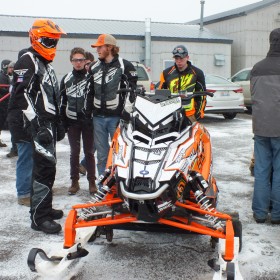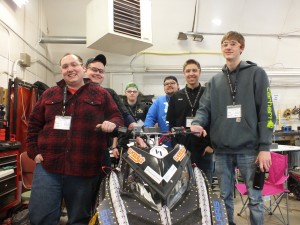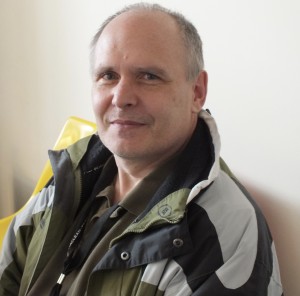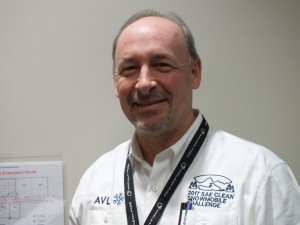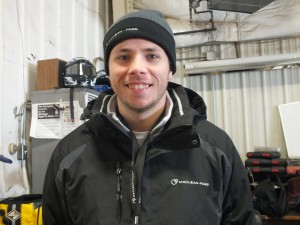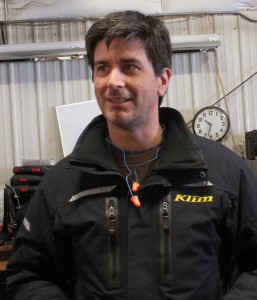by Cyndi Perkins and Sarah Williams
You can’t count on the weather at the annual Clean Snowmobile Challenge. And breakdowns? More a matter of if than when. But what you can predict with certainty is strong support from Michigan Tech alumni and friends.
This is the 18th year SAE International has run the event, and the 15th year Keweenaw Research Center at Houghton County Memorial Airpark has been the center of the action. The first three years of this event took place in and near Yellowstone National Park. Sponsorship support continues to grow. And it’s never taken for granted.
The cost to put on the challenge is about $200,000. Of that, about 80 percent comes from industry partners, 10 percent from local partners, and another 10 percent from snowmobile manufacturers, clubs and associations. Huskies chip in big time, providing sophisticated test equipment, can’t-do-without basics (think meals, tools, and sled-hauling equipment), and everything else needed for the University to host teams, judges, volunteers, and technicians from North America and beyond during the week-long quest to design quieter, more efficient sleds.
Helping to decrease engine emissions and improve fuel economy to make better snowmobiles is the focus for Sean Egmon and his team at AVL Test Systems Inc. The Austrian-based international company sends nine full-time employees to build the test cell that puts engine emissions to the test.
Egmon says he’s proud to support Michigan Tech, but it’s also a place to recruit future employees.
“These students have practical experience, they are hardworking, have good work ethics, and a lot of common sense,” he says. “That’s hard to find.”
The event combines learning in a teamwork environment and that’s good for employers (who are also sponsors) to see how students perform.
“On most job interviews it’s not possible to test and observe people in their work environment,” says Jim Christensen ’87. “Here we have an excellent opportunity to see students do the work that we do every day.”
Christensen helps with zero emission sleds, judges events and determines rules, and gives informal advice to teams. He brings 30 years of field experience in powertrain engineering and testing services.
Christensen and his wife Kim support the program to pay it forward to the next generation. “Michigan Tech gave me an excellent education,” he says. “My degree has served me well. I have the means to give back, and I want to.”
He says with state funding decreasing and universities relying more on alumni and friends for support, “it’s an opportunity to make up for that in a tiny way.”
High Winds Sideline Tuesday Endurance Run
Keweenaw’s wild weather kept organizers busy. They’re used to adapting. “On Monday, Houghton was hit with warm temps, thunder, lightning, and sleet. Tuesday morning, we had high hopes of running the endurance event to Copper Harbor. But on the practical side we knew it was doubtful due to water on the track and trails,” explains Jay Meldrum, KRC executive director and Clean Snowmobile Challenge lead organizer. “We chose the safe path, 60 miles on the KRC private test course.” Ten of the 13 internal combustion (IC) sleds who qualified were ready to start when winds gusted to nearly 70 mph. There were cheers for the pelting snow, followed by bad news from three highly skilled snowmobile riders on a test lap in newly built Polaris snowmobiles: sleds overheated because the track was a sheet of ice, with no loose snow to facilitate cooling.
This isn’t the first time organizers have regrouped. Meldrum remembers the opposite problem in 2003—no snow at KRC so they trailered the snowmobiles to Copper Harbor and ran the Endurance event on the Mandan route, at the edge of the world.
Students compete in three categories: traditional internal combustion (IC) gasoline-powered trail sled class; a diesel utility class, meant for backyard utility and pulling heavy loads such as in trail grooming; and the zero emissions (ZE) electric class, meant for North and South Pole scientific missions where hydrocarbon emissions skew research results and range is not a concern (less than 20 miles per charge). Meldrum notes ZE snowmobiles may also have a place in remote communities or at ski resorts where short rides are frequent and charging stations are available.
Tech’s Electric Team Starts from Scratch
Michigan Tech’s zero emissions (ZE) team celebrated a big accomplishment: passing the rigorous ZE technical inspection, for the second year in a row, with a different snowmobile. “It’s the hardest class,” says AJ Retting.
“The biggest project was getting all the CAD renderings to make the battery box and figuring what batteries to use” says team member Terry Gregoricka.
Teams—a record 25 this year—help each other, rather than hanging on to proprietary information. South Dakota School of Mines and Technology, for example, is using components similar to Tech’s, so the two groups share their findings, just as they share a similar goal of creating low-impact high-performance snowmobiles.
“Hopefully we’ll see a product go to market,” says Retting.
Polaris (yup, alumni here, too) donated the chassis. The batteries were also donated.
For Brian Johnson ’82, who works at Fiat Chrysler Automotive, it’s all about giving back to students and helping them become great engineers.
“Michigan Tech students are very devoted, committed. Competitions like this are great for students because they are interdisciplinary, much like the way industry is run. SAE teams prepare students to work for industry.”
Fiat Chrysler Automotive sponsors SAE motor sports teams and other Michigan Tech groups, Society of Women in Engineering, senior design projects, and Enterprise teams. The company also performs on-site testing at the KRC all winter.
Huskies Internal Combustion Entry Make a Fresh Start
Michigan Tech’s IC Team is regrouping after many of its members graduated last year. “It’s an almost entirely new team,” says team leader Mark Brouwer. Another new development: “We focused on sound reduction with a custom exhaust.”
Some recent graduates returned to the Clean Snowmobile Challenge, or came for the first time, to represent their companies.
Luke Roberts ’15 works for MacLean-Fogg, one of the event’s main sponsors. While not involved with the snowmobile challenge as a student, he now recruits students at Career Fair and this event.
“I may be biased, but Michigan Tech produces great engineers,” Roberts says. “It’s nice to be on the other side, giving the students the tools they need to be successful.”
Being part of the first Michigan Tech snowmobile team, helping to build the sled and then becoming a team leader keeps Joe Wegleitner ’04 returning each year.
“It’s a great networking event,” says Wegleitner, a consultant for Polaris Industries. “This event was a very important part of my education. You experience the team aspects here. Those are the same in an industry environment.”
Clean Snowmobile Challenge supporter Mark Rakoski ’95 also recruits and hires Michigan Tech students at Career Fair, and helped bring the display scoreboard to the MacInnes Student Ice Arena.
“The clean snowmobile program is great to see the engineering at work, teamwork presentation skills, and the ultimate ‘did you win or lose?’,” says Rakoski, who works for Mitsubishi Electric Automotive America Inc. “This is a good way to see the top talent in action (i.e. the ultimate working interview).”
Awards in several categories, ranging from best handling and fuel economy to lowest emissions, most practical solution, and quietest snowmobile were presented Saturday, but results won’t be formal until all the data collected is tabulated and cross-checked. Results will be announced in Michigan Tech News.
Editor’s Note: A special thank you to Cyndi Perkins, Web Writer at Michigan Tech, who braved the cold weather with me to help tell this story and take photos. Wearing snow gear and our safety goggles, we learned about snowmobiles and the great stories our alumni and students have to share.

